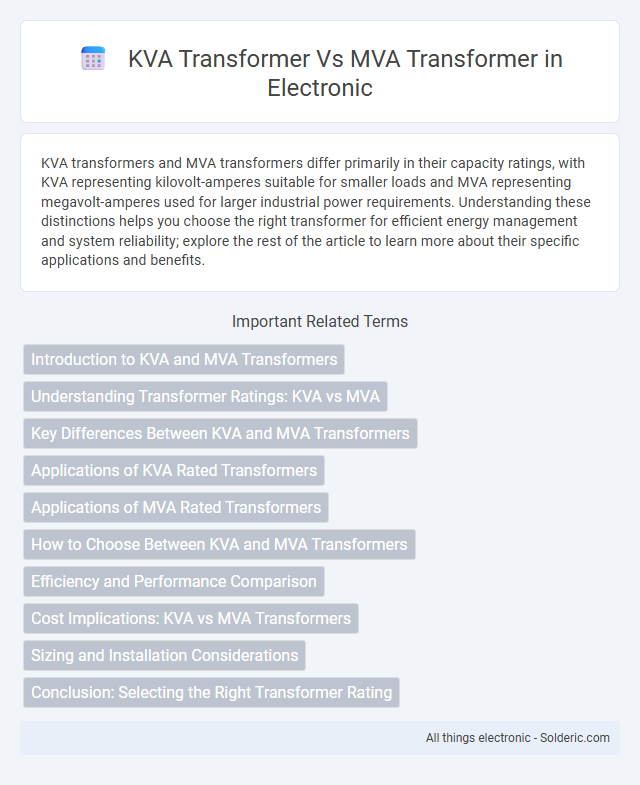KVA transformers and MVA transformers differ primarily in their capacity ratings, with KVA representing kilovolt-amperes suitable for smaller loads and MVA representing megavolt-amperes used for larger industrial power requirements. Understanding these distinctions helps you choose the right transformer for efficient energy management and system reliability; explore the rest of the article to learn more about their specific applications and benefits.
Comparison Table
| Feature | KVA Transformer | MVA Transformer |
|---|---|---|
| Unit of Power Rating | Kilo-Volt-Amperes (kVA) | Mega-Volt-Amperes (MVA) |
| Power Capacity | 1000 VA to 999,999 VA (up to 0.999 MVA) | 1 MVA and above |
| Typical Use | Small to medium electrical equipment | Large scale industrial and power station applications |
| Size and Weight | Smaller, lighter | Larger, heavier |
| Cost | Lower initial cost | Higher initial cost |
| Voltage Levels | Low to medium voltage | Medium to high voltage |
| Efficiency | Generally lower efficiency compared to MVA transformers | Higher efficiency due to advanced design and cooling |
| Cooling Methods | Oil-immersed or dry-type cooling | Advanced oil or forced air/water cooling systems |
Introduction to KVA and MVA Transformers
KVA transformers are rated in kilovolt-amperes, indicating their capacity to handle smaller electrical loads, commonly used in residential and light commercial applications. MVA transformers, rated in megavolt-amperes, support significantly larger power requirements typical in industrial plants and electrical substations. The difference in rating units reflects the scale of power each transformer is designed to manage, with 1 MVA equaling 1,000 KVA.
Understanding Transformer Ratings: KVA vs MVA
Transformer ratings are measured in kilovolt-amperes (KVA) and megavolt-amperes (MVA), indicating their apparent power capacity. A KVA transformer is suitable for smaller loads, typically under 1,000 KVA, while an MVA transformer handles larger industrial demands, starting from 1 MVA and above. Understanding these ratings helps you choose the right transformer size for your electrical system's efficiency and reliability.
Key Differences Between KVA and MVA Transformers
KVA transformers are rated in kilovolt-amperes and typically used for smaller applications, while MVA transformers are rated in megavolt-amperes and designed for large-scale industrial or utility use. The key differences between KVA and MVA transformers lie in their capacity, size, and typical usage scenarios, with MVA transformers handling higher power loads. Understanding your transformer rating in KVA or MVA helps ensure optimal selection for your electrical system's efficiency and safety.
Applications of KVA Rated Transformers
KVA rated transformers are primarily used in low to medium power applications such as residential buildings, small commercial facilities, and light industrial equipment where load requirements do not exceed a few hundred kilovolt-amperes. These transformers efficiently handle voltage regulation and energy distribution for localized systems, ensuring safety and cost-effectiveness in environments with moderate power demands. Their versatility makes them suitable for applications including emergency backup power, lighting circuits, and distribution in remote or off-grid locations.
Applications of MVA Rated Transformers
MVA rated transformers are primarily used in high-voltage power transmission and large-scale industrial applications where they handle substantial power loads exceeding 1,000 kVA. These transformers support electrical substations, power generation plants, and grid infrastructure, ensuring efficient energy distribution across vast networks. Their capacity to manage heavy electrical loads makes them essential for stability and reliability in utility-scale power systems.
How to Choose Between KVA and MVA Transformers
Choosing between KVA and MVA transformers depends primarily on the scale of the electrical load and application requirements. KVA transformers are suitable for smaller, localized systems such as residential or light commercial use where power demands are relatively low, typically under 1 MVA. For large industrial plants, utility substations, or power distribution networks requiring higher capacity and handling loads above 1 MVA, MVA transformers provide the necessary power rating and efficiency.
Efficiency and Performance Comparison
KVA transformers typically handle lower power ratings and are optimized for smaller-scale applications, often resulting in slightly higher losses and lower efficiency compared to MVA transformers designed for large-scale power transmission. MVA transformers, with higher capacity ratings, exhibit superior efficiency due to advanced core design and better materials, reducing energy losses during operation. Performance-wise, MVA transformers maintain voltage stability and load regulation more effectively under heavy loads, making them suitable for industrial and utility-scale power distribution.
Cost Implications: KVA vs MVA Transformers
KVA transformers typically have lower upfront costs compared to MVA transformers due to their smaller capacity and simpler design. MVA transformers, designed for higher power applications, involve higher material and manufacturing expenses, influencing overall project budgets significantly. Cost efficiency depends on matching transformer capacity precisely to load requirements, as under-sizing can lead to inefficiency and over-sizing increases capital expenditure unnecessarily.
Sizing and Installation Considerations
KVA transformers are typically used for smaller loads and require careful installation to avoid overloading, making them suitable for residential or light commercial applications. MVA transformers handle larger power capacities, necessitating robust infrastructure and precise sizing to ensure efficient energy distribution in industrial or utility-scale projects. Your choice between KVA and MVA transformers depends on the power demand and installation environment to optimize performance and safety.
Conclusion: Selecting the Right Transformer Rating
Choosing between a KVA transformer and an MVA transformer depends on the scale and demand of your electrical load, with KVA transformers suited for smaller, low-power applications and MVA transformers designed for large industrial or utility-scale power distribution. Properly matching the transformer rating to the load ensures efficiency, reliability, and cost-effectiveness in power delivery. Your decision impacts system performance, longevity, and overall operational safety.
KVA transformer vs MVA transformer Infographic

 solderic.com
solderic.com